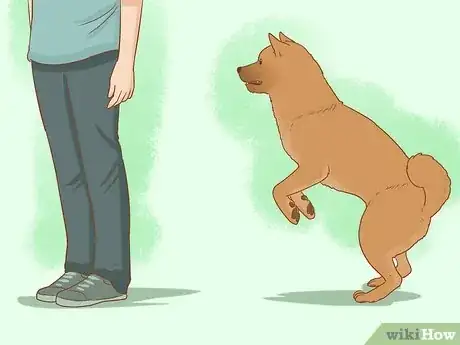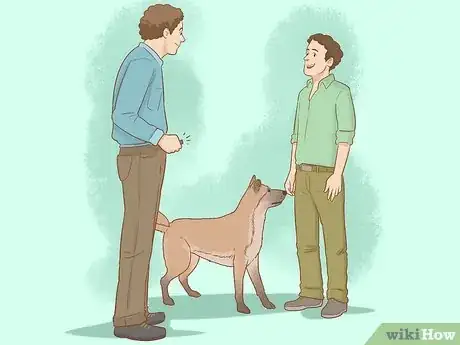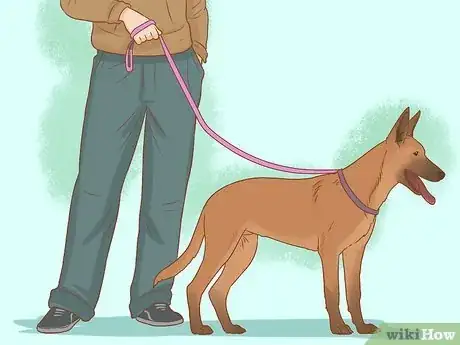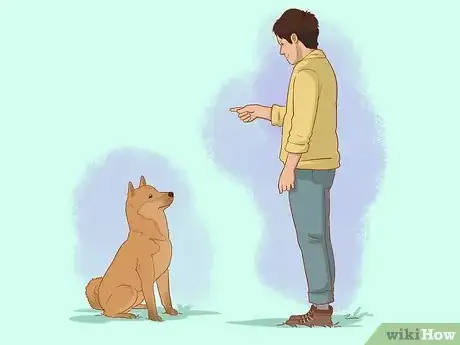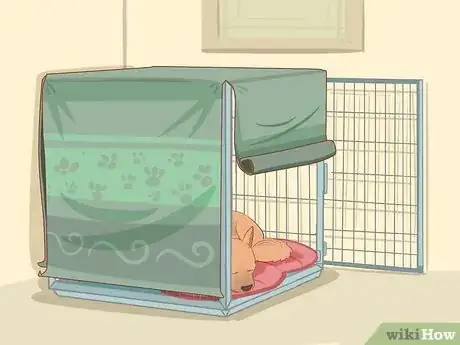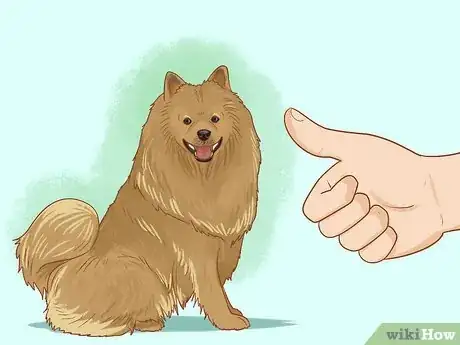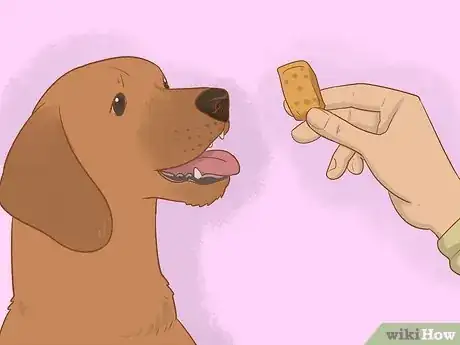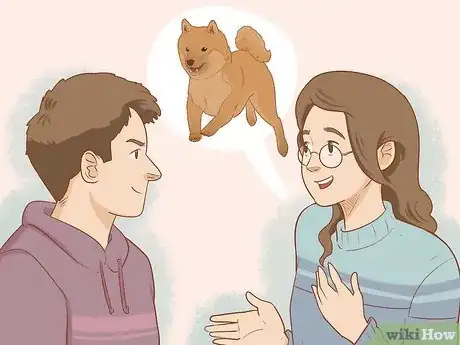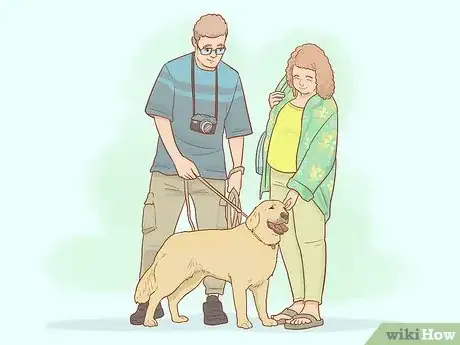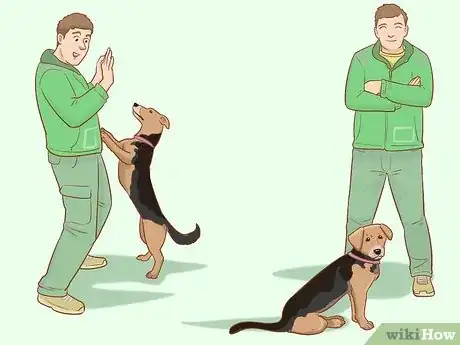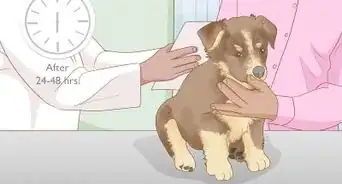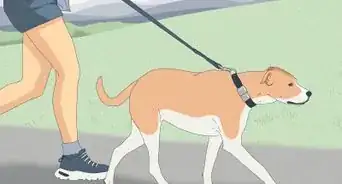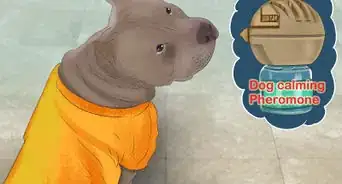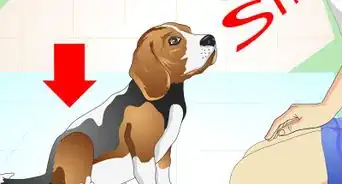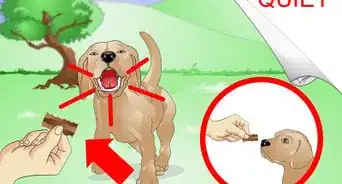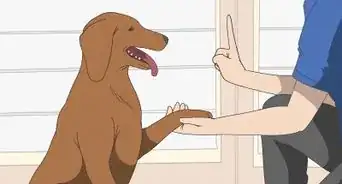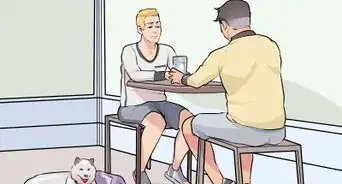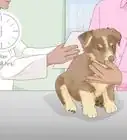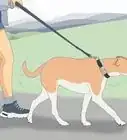This article was written by Sheri Williams and by wikiHow staff writer, Aly Rusciano. Sheri Williams is a Certified Dog Trainer and Behaviorist and the Owner of sheriwilliams.com, a business that specializes in teaching veterans how to turn their dogs into service dogs or emotional support animals to assist with PTSD. Based in the Los Angeles, California metro area, Sheri has over 20 years of dog training experience and also runs a general dog training practice specializing in rehabilitating dogs through positive reinforcement training techniques. She is certified by The Animal Behavior and Training Association.
There are 8 references cited in this article, which can be found at the bottom of the page.
This article has been viewed 22,998 times.
Is there anything better than your dog greeting you? Their little tail wags, and all they want is to kiss you, but what do you do when your pup starts jumping up on you or other people? Jumping is normal behavior for dogs—it’s how they channel their excitable energy and ask for attention. However, jumping-up behavior can be disruptive, especially to strangers. We’ve got everything you need to know about dogs jumping up on strangers, from the whys to the hows. Read on to learn how to keep your furry friend on their best behavior.
This article is based on an interview with our certified dog trainer and behaviorist, Sheri Williams, owner of sheriwilliams.com. Check out the full interview here.
Steps
How to Stop Your Dog from Jumping
-
1Ignore your dog’s jumping behavior. The first and best thing you can do is ignore your dog.[2] We know it’s hard disregarding that adorable face, but walk right by or stand really still. Dogs read body language to gauge their surroundings, and this will teach your pup that they won’t get attention by jumping up.
- By moving away or walking past your dog, your body language says, “I’m not giving you attention.”
- Think of it as acting like a tree. Don’t move. Don’t speak.
- Try the “turn your back” technique if you find ignoring your furry friend to be a bit tough. All you have to do is turn around when they try to jump up.[3]
- When your dog calms down and places all paws on the floor, bend over and acknowledge them with plenty of cuddles.
-
2Ask your friends to ignore your dog’s jumping too. A dog’s behavior won’t change without persistence. Let your friends and people you meet know that you’re training your dog to stop jumping up. If your pup approaches them, ask them to stay still or simply walk by. This will help your furry friend realize that you’re not the only one enforcing this new rule.[4] Try saying something like:
- “I can’t wait for you to meet Rex! But if he jumps up on you, please don’t acknowledge it. We’re working on that.”
- “Are you okay with dogs? Charlie’s big, and I’m warning you, he jumps. Just stand still and turn around. I’m training him, and the first step is ignoring the jumping.”
- “Jet is going to love you! He’s been jumping lately, and we’re still training, so please don’t pet or talk to him if he does jump on you.”
-
3Use a lead on your dog when people are near. A lead or leash is a great way to help train your dog to behave when meeting new people and put you back in control. If your pup starts to jump, give the lead a small tug. You can reel your pup back to your side and help calm their excitement.[5]
- Use commands like “sit” and “stay” when using the lead trick.
- Keep a distance between you and the stranger with your pup pulled closely at your side.
- Lessening the slack on the lead means your pup can’t jump too high.
- Dogs read body language, so stay calm when introducing your pup to new people.
-
4Train your dog to sit when meeting someone. This will help your dog associate meeting strangers with different behavior. If your pup starts jumping up, you can say “sit,” and they’ll be reminded of what they’re supposed to do—plus, they’ll get plenty of ear scratches in return. To teach the sit cue, all you need are a few treats and some patience.[6]
- Hold a treat out in front of your pup’s nose, just out of reach.
- Raise the treat towards your pup’s head, causing them to sit.
- Say “yes” when your pup’s bottom hits the ground and give them the treat.
-
5Put your dog in another room when guests come over. When you’re first training a dog to not jump up, it’s important to prevent any “rehearsing” behavior. This means avoiding all situations where your pup may get attention for jumping up. Simply place them in the room a few minutes before your guests arrive.[7]
- You can also keep your pup in their crate if your guests are only visiting for a short while.
- If you don’t have a separate room or crate, you can set up a dog or baby gate in a hallway to give your pup their own space.
- Explain to your guests that you’re training your dog, and if they want to meet them, they can’t acknowledge any jumping-up behavior.
-
6Teach your dog “default down.” This training technique can help calm an overly excited dog. Basically, “default down” is a start position for anything your pup wants. Your pup has to be lying down if they want anything—a treat, belly rub, walk, you name it.[8] Start by teaching your dog to sit, and then teach them the “down” command.[9]
- Once your pup knows the commands, ask them to lie down before getting anything. This will help them recognize that “down” should be their default behavior.
-
7Teach your dog to “stay.” When accompanied with “sit,” “stay” can prevent your pup from running up to a guest or stranger and jumping up on them. The word “stay” tells your pup to relax and keep still. Here are some tips for teaching your pup “stay:”[10]
- Start by teaching “sit,” moving on to “stay” once mastered.
- Only reward when your pup is completely still and doesn’t move.
- Increase the distance you move away after commanding “sit” over time.
- Train “sit” and “stay” by a front door to encourage friendly greetings.
-
8Teach your dog “four on the floor.” Only praise your dog when all paws are on the ground. This is an easy way to let your pup know that they won’t get any attention unless they’re standing or sitting on the ground. Soon, jumping will be a thing of the past![11]
- Keep some treats near the door to reward good behavior when greeting you or a stranger.
- Bend over right away when greeting your dog, so they don't have a chance to jump up.
-
9Try putting a doggie backpack on your dog. If your pup is still jumping up on people after trying multiple methods to make them stop, your doggo may need a little extra support. Doggie backpacks are designed to hug, soothe, and calm dogs. Paired with other commands like “sit,” the doggie backpack can help your pup greet strangers with confidence.[12]
- Talk to your veterinarian about your pup’s anxiety and stress levels. They’ll be able to recommend the right doggie backpack for your dog and provide personalized care.
-
10Reward your dog’s good behavior with treats. When your furry friend does something right, give them a treat or praise in a timely manner. The more you acknowledge and reward good behavior, the more likely your pup will want to keep being good![13]
- Reward your pup immediately after they do something good, so they can associate the action with the reward.
- Only reward your pup when they’re standing or sitting on all paws.
- Try to keep others from giving your pup treats as this can distract and derail your training.[14]
Expert Q&A
-
QuestionHow do I give my dog enough attention?
 Dee HoultDee Hoult is the CEO of Applause Your Paws, Inc., South Florida's largest privately-owned dog training company. With over 15 years of experience, Dee specializes in correcting dog behavior problems by providing engaging, positive education and non-intimidating training. Dee holds a BS in Marine Science and Biology and an MBA from the University of Miami. She is a credentialed Certified Professional Dog Trainer through the Certification Council for Professional Dog Trainers and a credentialed Certified Dog Behavior Consultant (CDBC) through the International Association of Applied Behavior Consultants (IAABC). In 2018, Dee was a finalist for Woman of the Year for the Women in the Pet Industry Awards.
Dee HoultDee Hoult is the CEO of Applause Your Paws, Inc., South Florida's largest privately-owned dog training company. With over 15 years of experience, Dee specializes in correcting dog behavior problems by providing engaging, positive education and non-intimidating training. Dee holds a BS in Marine Science and Biology and an MBA from the University of Miami. She is a credentialed Certified Professional Dog Trainer through the Certification Council for Professional Dog Trainers and a credentialed Certified Dog Behavior Consultant (CDBC) through the International Association of Applied Behavior Consultants (IAABC). In 2018, Dee was a finalist for Woman of the Year for the Women in the Pet Industry Awards.
Certified Dog Behavior Consultant To make sure your dog gets enough attention, give your dog lots of pets and praise. Additionally, play with your dog and take it for exercise daily. Make sure you're also giving your dog enough food and water to meet its physical needs.
To make sure your dog gets enough attention, give your dog lots of pets and praise. Additionally, play with your dog and take it for exercise daily. Make sure you're also giving your dog enough food and water to meet its physical needs.
References
- ↑ https://www.animalhumanesociety.org/news/pet-dish-tv-managing-mouthing-and-jumping-dogs
- ↑ https://www.animalhumanesociety.org/news/pet-dish-tv-managing-mouthing-and-jumping-dogs
- ↑ https://youtu.be/QEH1TBEidj0?t=60
- ↑ https://resources.bestfriends.org/article/dog-jumping
- ↑ https://www.thekennelclub.org.uk/dog-training/getting-started-in-dog-training/dog-training-and-games/how-do-i-stop-my-dog-from-jumping-up/
- ↑ https://resources.bestfriends.org/article/dog-jumping
- ↑ https://resources.bestfriends.org/article/dog-jumping
- ↑ https://bestfriends.org/stories/features/jumpy-and-mouthy-dog-gets-centered
- ↑ https://aawl.org/sites/default/files/teaching_your_dog_the_down_command.pdf
- ↑ https://indoorpet.osu.edu/dogs/puppy/basic-manners
- ↑ https://www.dogstrust.org.uk/help-advice/training/jumping-up-training
- ↑ https://bestfriends.org/stories/features/jumpy-and-mouthy-dog-gets-centered
- ↑ https://www.animalhumanesociety.org/news/pet-dish-tv-managing-mouthing-and-jumping-dogs
- ↑ https://www.thekennelclub.org.uk/dog-training/getting-started-in-dog-training/dog-training-and-games/how-do-i-stop-my-dog-from-jumping-up/
- ↑ https://www.dogstrust.org.uk/help-advice/training/jumping-up-training

